The Prambanan temple complex in Indonesia is a captivating showcase of Hindu architecture and mythology. Dedicated to the Trimurti deities – Shiva, Brahma, and Vishnu – this 9th-century marvel features intricate bas-relief carvings that narrate the epic tale of the Ramayana. Surrounded by over 200 smaller shrines, the site intertwines spirituality with artistry, offering visitors a profound glimpse into the cultural heritage and religious narratives that shape Indonesia’s landscape. As you explore the grounds, you’ll be transported to a realm where the divine and the earthly collide, leaving you intrigued to uncover more about this remarkable temple complex.
Key Points
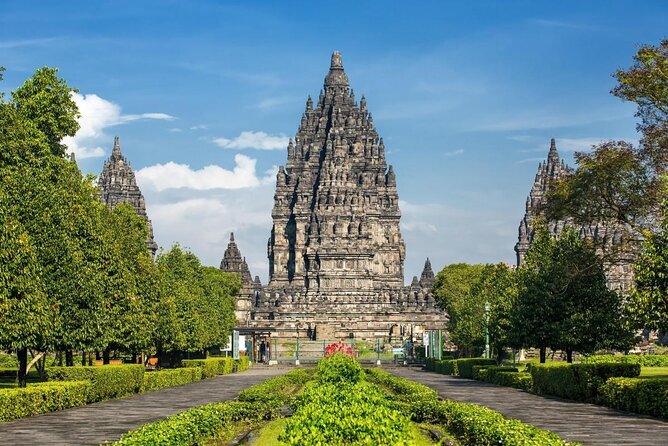
- The Prambanan temple complex features three major shrines dedicated to the Trimurti deities – Shiva, Brahma, and Vishnu – symbolizing the cyclical nature of creation, preservation, and destruction.
- The intricate wall carvings and statues at Prambanan manifest fundamental Hindu principles and provide an immersive understanding of the religion’s roots and cultural heritage.
- Adjacent shrines like Candi Plaosan and Candi Sewu blend Hindu and Buddhist influences, highlighting the intertwined religious narratives shaping Yogyakarta’s cultural landscape.
- Visitors to Prambanan must adhere to specific etiquette, such as appropriate attire, removal of shoes, and quiet, reverent movement, to maintain the sanctity of the site.
- Exploring Prambanan with knowledgeable guides enhances the understanding of the temple’s history and mythology, including the significance of the Trimurti temples and the captivating Ramayana epic carvings.
The Trimurti Deities

At the heart of Prambanan’s religious significance lie the three principal deities of Hinduism – Shiva, Brahma, and Vishnu, known collectively as the Trimurti.
Towering at the center of the temple complex are three major shrines dedicated to these divine figures. The largest structure is the Shiva temple, flanked by the smaller shrines of Brahma and Vishnu.
This symbolic arrangement represents the Hindu belief in the cyclical nature of creation, preservation, and destruction – the divine triad that governs the cosmic order.
Through intricate wall carvings and statues, the temple complex provides a tangible manifestation of these fundamental Hindu principles.
You can also read our reviews of more tours and experiences in Yogyakarta.
Architectural Splendor
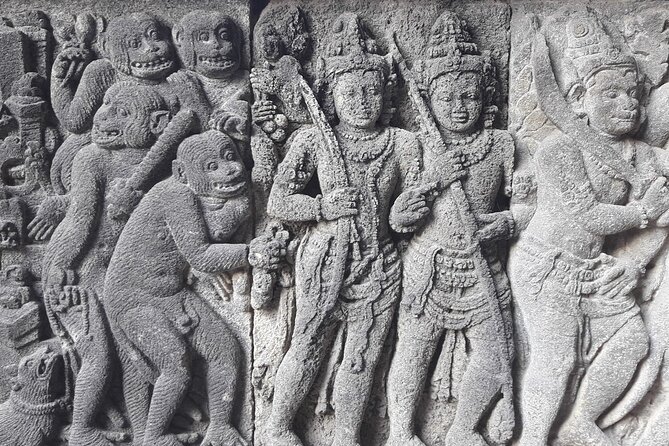
Towering with architectural grandeur, the Prambanan temple complex captivates visitors with its intricate design and ornate details.
Constructed in the 9th century, the main structures feature a tiered layout with three main temples dedicated to the Trimurti deities – Shiva, Brahma, and Vishnu.
Adorning the walls are intricate bas-relief carvings depicting scenes from the Hindu epic Ramayana.
Surrounding the central temples are over 200 smaller shrines, creating a vast and awe-inspiring site.
The temple’s impressive scale and attention to detail showcase the engineering prowess and spiritual devotion of the Sanjaya Dynasty that commissioned this remarkable Hindu sanctuary.
Carved Epics
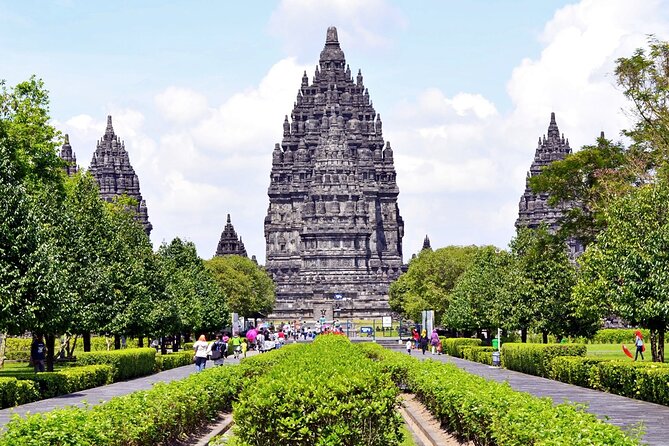
The walls of the Prambanan temple complex come alive with intricate carvings that depict scenes from the Hindu epic Ramayana.
These carvings tell the story of the heroic prince Rama‘s journey to rescue his wife Sita from the demon king Ravana. Visitors can trace the epic’s narrative through the temple’s elaborate bas-reliefs, which showcase the characters’ adventures and battles in stunning detail.
The skillful craftsmanship and the sheer scale of these carved epics leave visitors in awe of the artistry and the religious devotion that inspired their creation centuries ago.
Exploring these carvings provides an immersive understanding of the temple’s deep Hindu roots and the rich cultural heritage of the region.
Neighboring Shrines
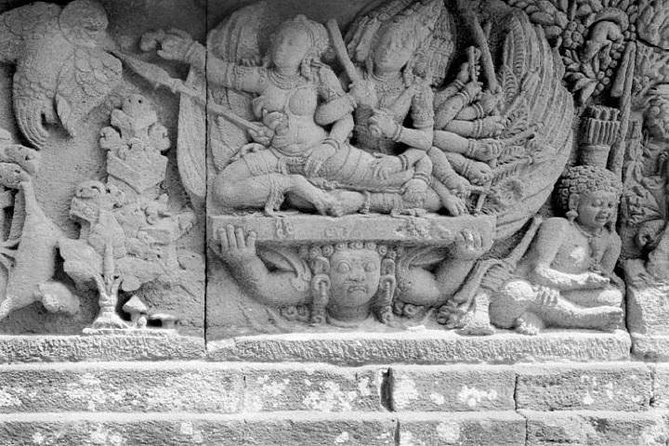
Nestled adjacent to the grand Prambanan complex, visitors can discover neighboring shrines that showcase a harmonious blend of Hindu and Buddhist influences.
These lesser-known gems, such as Candi Plaosan and Candi Sewu, offer a deeper understanding of the region’s rich religious history:
-
Candi Plaosan: A Buddhist monastery complex featuring intricate carvings and the remnants of multiple temples, reflecting the coexistence of Hindu and Buddhist faiths.
-
Candi Sewu: The second-largest Buddhist temple compound in Indonesia, boasting over 200 structures and stunning carved reliefs depicting scenes from Buddhist mythology.
Exploring these neighboring sites provides a unique opportunity to witness the intertwined religious narratives that have shaped the cultural landscape of Yogyakarta.
Visitor Etiquette
Respecting the sanctity of Prambanan Temple requires visitors to follow certain etiquette guidelines.
Appropriate attire is essential – shoulders and knees should be covered to show respect for the sacred site. Visitors must also remove their shoes before entering the temple complex.
Flash photography is prohibited, as it can damage the delicate structures and carvings. Guests are encouraged to move quietly and reverently through the grounds, avoiding loud noises or disruptive behavior.
Exceptional Experiences
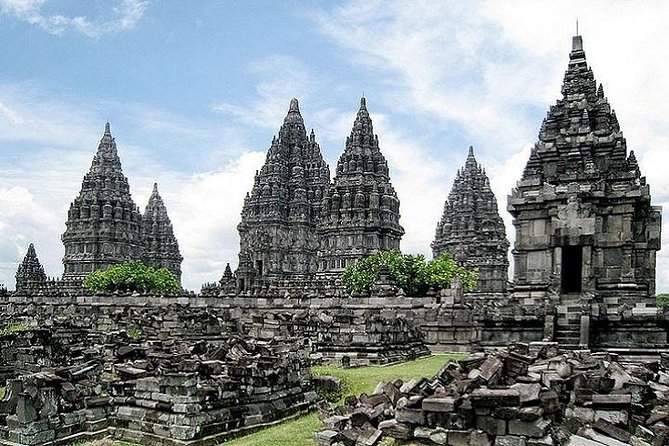
Many visitors have praised the exceptional experiences offered by the Prambanan temple tour. The knowledgeable guides bring the temple’s history and mythology to life, allowing guests to fully enjoy the Hindu realms.
Key highlights include:
- Exploring the awe-inspiring Trimurti temples dedicated to Shiva, Vishnu, and Brahma, and learning about their significance.
- Marveling at the intricate wall carvings depicting the captivating Ramayana epic.
- Visiting the neighboring shrines of Candi Plaosan and Candi Sewu, which showcase a blend of Hindu and Buddhist influences.
Guests consistently rate the Prambanan tour experience as exceptional, citing the exceptional value and the opportunity to deeply connect with this UNESCO World Heritage site.
Tour Logistics
The Prambanan temple tour includes a private half-day excursion from Yogyakarta hotels.
The tour lasts about 4 hours, with a 45-minute drive to the temple complex. Guests will explore the Trimurti temples and learn about the Ramayana epic from a professional English-speaking guide.
The tour also visits the neighboring shrines of Candi Plaosan and Candi Sewu, which have both Hindu and Buddhist origins.
Admission fees are included, but personal expenses like meals, drinks, tips, and shopping are not. Guests should dress appropriately and bring sun protection due to the tropical climate.
Free cancellation is available up to 24 hours before the tour.
Useful Tips
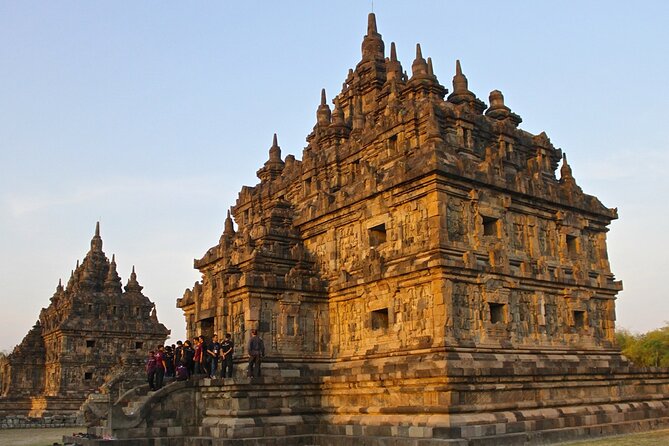
When visiting Prambanan, guests should dress conservatively, covering their shoulders and knees, to respect the sacred nature of the site. Staying hydrated and protected from the tropical sun is also crucial, as the site can get quite hot.
Additionally:
- Bring sun protection, such as a hat, sunglasses, and sunscreen, to ensure a comfortable experience.
- Wear comfortable walking shoes, as the temple complex covers a large area and requires extensive exploration.
- Prepare for potential crowds, especially during peak tourist seasons, by arriving early or considering a private tour for a more personalized experience.
Frequently Asked Questions
Is It Possible to Climb to the Top of the Temples?
Visitors can’t climb to the top of the temples. Access to the upper levels is restricted for safety reasons, but guests can explore the base of the temples and admire their intricate architecture from the ground.
How Long Has the Restoration Process Been Ongoing?
The restoration process at Prambanan Temple has been ongoing for decades. After a major earthquake in 2006, extensive restoration work was undertaken to repair the damage and stabilize the structures, an effort that continues today.
Can I Take Photographs Inside the Temples?
Yes, visitors are allowed to take photographs inside the Prambanan Temple complex. However, they should be mindful of not disturbing other visitors and following any local rules or guidelines regarding photography within the sacred Hindu site.
Are There Any Special Religious Events Held at Prambanan?
Prambanan Temple hosts several Hindu festivals throughout the year, including Waisak and Galungan celebrations. During these events, visitors can witness colorful processions, offerings, and traditional performances celebrating the temple’s religious and cultural significance.
Is It Safe to Visit Prambanan During the Rainy Season?
It’s generally safe to visit Prambanan during the rainy season, though visitors should dress appropriately and be aware of potential muddy conditions. The temple complex remains open year-round, and the rainfall can create a serene and peaceful atmosphere for exploration.
Recap
The Prambanan temple complex is a stunning testament to the rich cultural and religious heritage of Indonesia. Dedicated to the Trimurti deities, this 9th-century marvel showcases intricate carvings that narrate the epic tale of the Ramayana. Surrounded by over 200 smaller shrines, Prambanan offers visitors a profound glimpse into the spiritual tapestry that shapes the nation’s landscape, leaving a lasting impression on all who experience its exceptional beauty and cultural significance.
More Tour Reviews in Yogyakarta
Not for you? Here's more things to do in Yogyakarta we have recnetly reviewed
- 4 Best Dining Experiences In Yogyakarta
- 12 Best 2 Day Tours In Yogyakarta
- 11 Best 3 Day Tours In Yogyakarta
- 9 Best 4 Day Tours In Yogyakarta
- 16 Best Food Tours In Yogyakarta
- 12 Best Full-Day Tours In Yogyakarta
- 4 Best Dinner Tours In Yogyakarta
- Yogyakarta: Jomblang Cave & Timang Beach Gondola
- Prambanan, Hidden Temple, & Paralayang Hill Sunset
- Yogyakarta Transport Service
- Lava Tour Jeep Merapi
- Private Transfer From Yogyakarta Airport (Jog) to Brontokusuman
